It was a YouTube viewer response that burst my bubble of complacency when it comes to repair/inflator kits replacing physical spare tyres in an increasing number of new cars on sale in the Aussie market.
Below a recent review of the Nissan X-Trail e-Power hybrid, Trojan Hman asked, "Is there a spare tyre?"
We let him know the car's equipped with a repair/inflator kit, and the response was as spirited as it was rapid.
"That isn't good enough. We need to have an open communication with these companies. Who is it that's saying Australians will be fine without a spare tyre?"
I found myself instantly agreeing, at the same time realising I'd been suffering from boiling frog syndrome.
But rather than gradually rising water temperature, here the stealthy disappearance of the humble spare tyre had snuck up on me.

The thin edge of the spare replacement wedge appeared in the late '70s with exotic supercars saving weight and optimising packaging via deployment of a skinny, speed-limited 'space saver'.
The idea was borrowed from the aerospace industry and started to catch on in the mainstream through the '90s.
Into the noughties even it was sidelined by the combination of a pressurised sealant canister and compact compressor.
As the diameter of rims fitted to even humble grocery-getters has increased, the presence of a full-size physical spare has decreased commensurately.
Every now and then the issue flares up. Australians travel long distances, often in remote areas, so the evocatively nick-named 'can of goo' isn't reliable enough.
But for an OEM engineer, trying desperately to hit a fuel economy number, or accommodate a packaging hard point, the temptation of that ultra-lightweight, shoe box-sized 'mobility kit' is hard to resist.

However, those advantages for the manufacturer turn into a potential disaster for the consumer.
You're barrelling along the road less travelled in your Audi RS Q8 with the family on-board.
It's scorching hot outside but you're all cool as cucumbers in the leather-lined cabin with the massive 23-inch rims shod with that licorice-thin, high-performance rubber humming along underneath you.
Until it's not.
A nasty puncture has blown a big hole in your progress and collective comfort level.
You pull out the repair kit, but a piece of bone from a recent road kill has pierced the sidewall and the repair goo isn't worth the can it's sealed in.
The CarsGuide editorial team's experience backs up the accepted wisdom that if the puncture is more than 4.0mm in diameter, or outside the main tread area, or the wheel rim is damaged, you're out of luck. The goo will just push through and not seal the hole.
.jpg)
Phone reception's dodgy, and even if you could get through to Honest Joe's Tyres in the nearest town, 50km away, it's unlikely they'll have a 23-inch Z-rated 295/35 Continental SportContact gathering dust on the shelf.
In other words, you're stuffed! What follows, no matter how accommodating the roadside assistance provider is, is a teeth-grindingly tedious process involving a flat bed truck, inconvenience and discomfort.
Sure, the RS Q8 on an outback B-road is an extreme example. With those massive alloys it's more at home with the donks at a Miami car show than in the Aussie bush.
But the principle stands up. There's nothing like a physical spare, full-size ideally, but space-saver at a pinch, to get you on your way with a minimum of fuss and risk. There's a reason outback adventurers stock up with multiple spares mounted to their 4WDs.

Maybe the 'run-flat' tyre, at various times adopted almost across the board by the likes of BMW and others, is a win-win solution? But that concept's comfort/function compromise could be the subject of another column all on its own.
The conundrum facing carmakers and buyers is possibly best summed up by Subaru going with a full-size, boot-filling (alloy) spare in its BRZ, while Toyota has opted for a luggage space-liberating repair kit in the near identical GR 86.
What do you think? Is it time for protests in the streets, or am I overthinking a perfectly acceptable engineering-driven decision?


.jpg)



.jpg)



 copy.jpg)


.jpg)

.jpg)


.jpg)

Comments